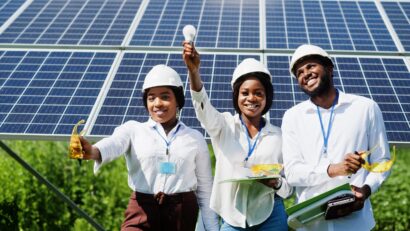Black Mirror’s pessimism porn won’t lead us to a better future | Louis Anslow
Detta inlägg post publicerades ursprungligen på denna sida this site Läs mer…
Nyheter och länkar - en bra startsida helt enkelt |Oculus lyx vitae
Detta inlägg post publicerades ursprungligen på denna sida this site Läs mer…
Detta inlägg post publicerades ursprungligen på denna sida this site Läs mer…

Power outages – hardly imaginable in many parts of the world today. Yet in rural regions of East Africa, a lack of reliable energy was long an everyday reality. Today, however, communal solar power systems are transforming lives: they provide clean electricity that not only protects the climate but also improves health, education, and economic opportunities.
It’s nighttime at the Ndilidau Health Center in southeastern Kenya, near the border with Tanzania. Midwife Jacinta Malemba shines a flashlight into the darkness – just another of the countless nights when power outages disrupted the clinic’s operations. “We never lost anyone, but we often had to take great risks,” Jacinta recalls. The unreliable energy supply repeatedly brought the clinic’s work to a standstill: without electricity, equipment couldn’t be sterilized, vaccines and medicines couldn’t be refrigerated, and critical examinations had to be postponed.
Births in the Dark Are Now History
Today, the situation has changed dramatically. The small health center, serving twelve nearby villages with around 8,000 residents, now has its own solar power system, ensuring a reliable electricity supply. The impact on the community has been profound: pumps provide clean water for drinking and cooking, medical facilities can reliably operate their equipment, and local businesses benefit from stable energy access. These projects go far beyond basic power supply – they enhance education, healthcare, and economic growth.
Community Solar Power: A Collective Solution to Energy Poverty
The Ndilidau Health Center is one example in Kenya, Tanzania, and Uganda where communal solar systems transform lives. These systems are often centrally installed for villages or household groups. Alternatively, they may operate as independent mini-grids, offering shared electricity access. Sharing power from one installation reduces costs and resource use while ensuring more sustainable energy solutions for communities.
In the Napenda Solar Community, located south of Nairobi, residents not only gain access to clean energy. They also also receive training on how solar systems work, how to build them, and how to maintain them. This knowledge empowers communities to operate and manage these systems independently for the long term. In rural regions without access to centralized power grids, such projects provide a reliable and sustainable energy supply.
[embedded content]
Solar vs. Kerosene and Diesel: Cleaner, Safer, More Affordable
Solar systems offer a sustainable alternative to kerosene and diesel generators, which were long the primary sources of electricity for many households. These traditional fuels not only harm health because of soot and smoke, but they also significantly damage the environment. Furthermore, they are inefficient, hazardous, and increasingly expensive over time. Communal solar systems, by contrast, are clean, safe, and cost-effective.
These systems often operate under a pay-as-you-go model: households pay a small deposit for installation, with subsequent usage costs settled in flexible, mobile installments. Well-known payment platforms like M-PESA, widely used in Kenya, facilitate this process. M-PESA enables users to make payments and transfers via mobile phones, even in areas without bank access.
A standout example is M-KOPA Solar, a Kenyan company offering solar solutions under this model. Customers first pay an initial fee of 35 USD. They then make daily payments of 0.45 USD, often lower than kerosene costs. After about a year, households fully own the solar system. This approach makes clean energy both accessible and practical. It also reduces costs and significantly improves living conditions, creating long-term benefits for families.
Bridging Africa’s Energy Gap with Solar Power
Globally, 1.3 billion people lack access to electricity, while another billion face unreliable supply. In Sub-Saharan Africa, about half the population lives without power. Off-grid solar systems could play a crucial role in bridging this gap. According to a study by the European Investment Bank and the International Solar Alliance, these systems could provide electricity to 120 million households across Africa.
The International Energy Agency (IEA) predicts solar energy will dominate off-grid systems in Sub-Saharan Africa by 2040. Kenya aims to cut carbon emissions by 30% by 2030. The country promotes renewable energy through the National Climate Change Action Plan. Solar power combines climate action with innovation. It paves the way for a sustainable and fair energy future. Läs mer…

While the economy in some EU countries is stagnating and even slipping into recession, Spain’s economy is showing rapid growth. Spain’s socialist Prime Minister, Pedro Sánchez, has implemented government interventions to regulate prices. This approach has kept inflation low over the past few years and stimulated economic growth. As a result, Spain is now a driving force within the EU and is projected to have the highest economic growth rate in the Eurozone for 2024.
Price Controls as a Successful Economic Strategy
Spain is one of the EU countries that has weathered the COVID-19 pandemic, energy crisis, and inflation surge particularly well. Its economic growth in recent years has far surpassed the EU average, and predictions for 2024 estimate a growth rate of 2.4–2.7%, making Spain the fastest-growing economy in the Eurozone. The Sánchez government took action during the energy crisis by intervening in prices, which helped keep inflation consistently low. Key measures included a gas price cap and rent controls, which helped curb price increases. In addition, the government suspended VAT on essential food items, helping to ease the burden of rising food costs.
Immigration as a Key to Spain’s Prosperity
Another factor behind Spain’s strong economic growth is the influx of skilled workers, particularly from Latin America. This immigration has eased the labor shortage in sectors like technology and hospitality. New immigration policies are expected to support this trend further.
While many European countries focus on restricting immigration, Spain has embraced an open approach. In mid-October 2024, Sánchez presented his plans to the Spanish Parliament, emphasizing that immigration is not only a humanitarian issue but also essential for the country’s economic future:
“It is necessary for the prosperity of our economy and the sustainability of the welfare state.”
The government plans to simplify the recognition of foreign qualifications, introduce a new labor migration program, and reduce bureaucratic hurdles for residence permits. At the same time, integration measures are being expanded.
Lowest Unemployment Rate in 15 Years
Spain’s unemployment rate skyrocketed following the financial crisis of the late 2000s. However, it has now fallen to around 11.3%, the lowest level in 15 years. This improvement is largely due to the robust economic growth under Sánchez’s leadership during recent crises.
Despite being high by European standards, many sectors in Spain, such as technology and construction, are facing a shortage of skilled workers. Rural areas, in particular, are struggling with depopulation and are finding it increasingly difficult to maintain essential infrastructure.
“We have elderly people who need caregivers but can’t find them. Businesses are looking for programmers, technicians, and builders but can’t find them. Rural schools need more children to avoid closing,” said Prime Minister Sánchez.
Sánchez also plans to ask the European Commission to bring forward the implementation of the EU-wide migration pact to next year. Under this plan, migrants and asylum seekers would be more evenly distributed among EU member states based on factors like GDP and population.
Spain’s Financial Market More Stable than France
Spain’s positive economic developments are also reflected in its financial market. Recently, the yields on 10-year French government bonds surpassed those of Spain for the first time. In simple terms, investors now receive a higher return for purchasing French government bonds compared to Spanish ones, suggesting that investors see Spain as a lower-risk country than France, the EU’s second-largest economy.
In January 2024, Spain’s bond yields were still 0.4 percentage points higher than France’s. During the worst of the Eurozone crisis, the difference between Spanish and French bonds was nearly five percentage points.
This article was updated on October 11 to include the information that Spain intends to focus on migration in its labor market policy in the future.
This work is licensed under the Creative Common License. It can be republished for free, either translated or in the original language. In both cases, please cite Kontrast / Michael Thaler as the original source/author and set a link to this article on Scoop.me. https://thebetter.news/spain-economy-boom/
The rights to the content remain with the original publisher. Läs mer…